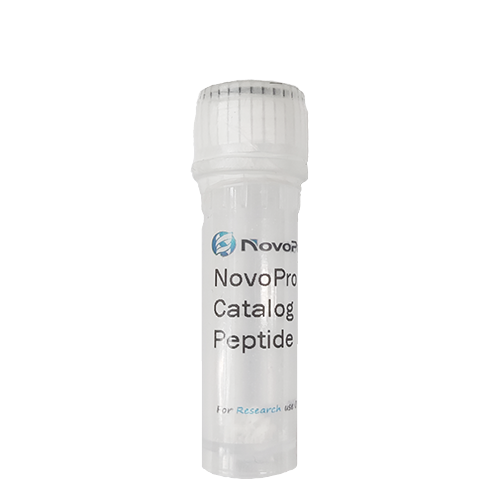α-Synuclein (61-95) (human) peptide
Not For Human Use, Lab Use Only.
Cat.#: 315616
Special Price 442.80 USD
-
Product Name
α-Synuclein (61-95) (human) peptide
-
Documents
Batch to batch variation of the purity
-
Sequence Shortening
EQVTNVGGAVVTGVTAVAQKTVEGAGSIAAATGFV
-
Sequence
Glu-Gln-Val-Thr-Asn-Val-Gly-Gly-Ala-Val-Val-Thr-Gly-Val-Thr-Ala-Val-Ala-Gln-Lys-Thr-Val-Glu-Gly-Ala-Gly-Ser-Ile-Ala-Ala-Ala-Thr-Gly-Phe-Val
-
Length (aa)
35
-
Peptide Purity (HPLC)
98.1%
-
Molecular Formula
C141H235N39O49
-
Molecular Weight
3260.68
-
Source
Synthetic
-
Form
Powder
-
Description
The 35 amino acid peptide NAC (α-synuclein (61-95)) has originally been isolated from the insoluble core of Alzheimer's disease (AD) amyloid plaque. The sequence corresponds to a fragment of a 140 amino acid precursor known as NACP or α-synuclein and was found to form amyloid fibrils via a nucleation-dependent polymerization mechanism. Accumulation of NAC aggregates in the synapse might be responsible for the neurodegeneration in AD and in the prion diseases.
-
Storage Guidelines
Normally, this peptide will be delivered in lyophilized form and should be stored in a freezer at or below -20 °C. For more details, please refer to the manual: Handling and Storage of Synthetic Peptides
-
References
- Tabner BJ, Turnbull S, El-Agnaf OM, Allsop D. Formation of hydrogen peroxide and hydroxyl radicals from A(beta) and alpha-synuclein as a possible mechanism of cell death in Alzheimer's disease and Parkinson's disease. Free Radic Biol Med. 2002 Jun 1;32(11):1076-83. doi: 10.1016/s0891-5849(02)00801-8. PMID: 12031892.
-
About TFA salt
Trifluoroacetic acid (TFA) is a common counterion from the purification process using High-Performance Liquid Chromatography (HPLC). The presence of TFA can affect the peptide's net weight, appearance, and solubility.
Impact on Net Weight: The TFA salt contributes to the total mass of the product. In most cases, the peptide content constitutes >80% of the total weight, with TFA accounting for the remainder.
Solubility: TFA salts generally enhance the solubility of peptides in aqueous solutions.
In Biological Assays: For most standard in vitro assays, the residual TFA levels do not cause interference. However, for highly sensitive cellular or biochemical studies, please be aware of its presence.
-
Molar Concentration Calculator
-
Dilution Calculator
-
Percent Concentration Calculator
Mass (g) = Concentration (mol/L) × Volume (L) × Molecular Weight (g/mol)
Related Products / Services
• Peptide Services: NovoPro's peptide synthesis services include standard chemical peptide synthesis, peptide modification, peptide libraries, and recombinant peptide expression.
• Standard Peptide Synthesis: NovoPro offers quality peptides at the most competitive prices in the industry, starting at $3.20 per amino acid. NovoPro provides PepBox – Automatic Quote Tool for online price calculation.
• Peptide Modifications: NovoPro offers a wide range of peptide modification services including isotope labeling (2H, 15N, and 13C), multiple disulfide bonds, multiple phosphorylations, KLH, BSA, ovalbumin, amidation, acetylation, biotin, FITC, etc.
Please note: All products are "FOR RESEARCH USE ONLY AND ARE NOT INTENDED FOR DIAGNOSTIC OR THERAPEUTIC USE"

